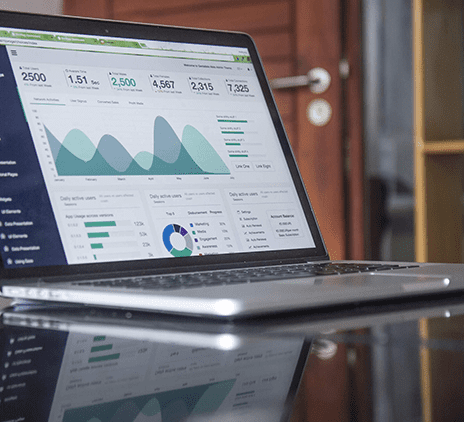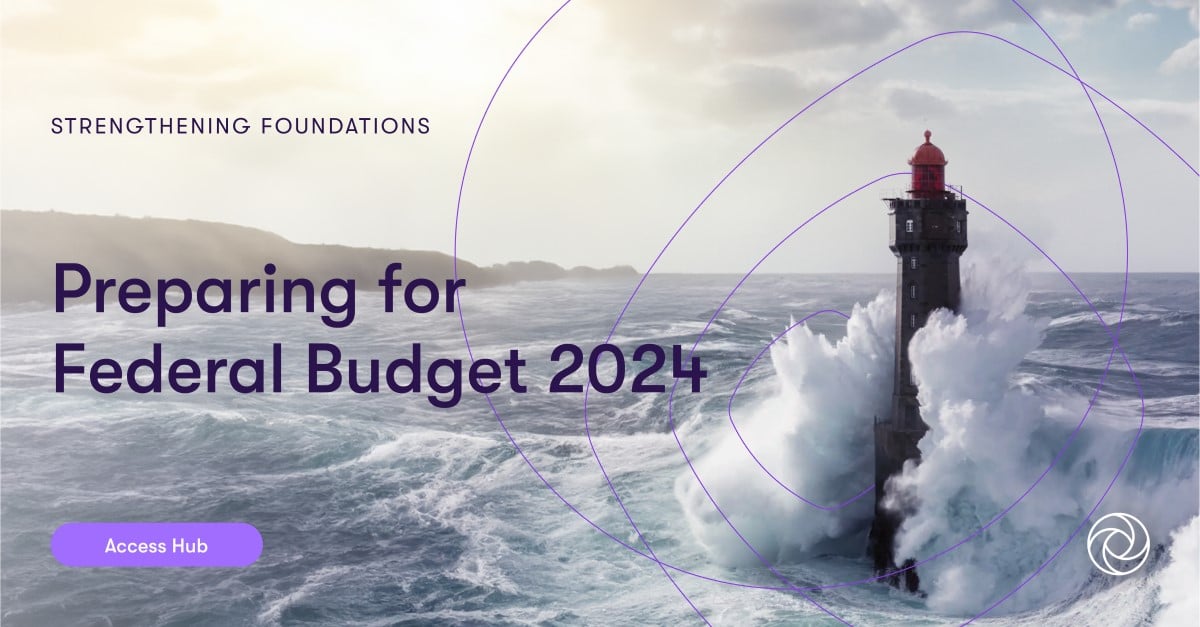Rebecca Archer
Welcome to Beyond the Numbers with Grant Thornton – a podcast exploring trends in business and the marketplace.
I’m Rebecca Archer and today I am thrilled to bring you our special Federal Budget edition of Beyond the Numbers. Today we’ll hear from Network TEN Journalist Hugh Riminton, Chief Economist Besa Deda, and Grant Thornton Partner Jared Grima at our Virtual Seminar as they discuss the Budget spending.
The Government faces a significant challenge as the economy continues to slow down. This economic downturn is the most severe in 23 years, and it comes at a critical time as the country approaches an election year.
So, what has been revealed in the Federal Budget 2024 and how might the allocated spending affect your business?
Hugh Riminton
Welcome to Budget 2024 for the Grant Thornton special coverage of this Budget. We've been going through all the documents; we've been talking to the Treasurer – or at least I have last night in Canberra. We've been doing all of this so that you don't have to, and over the next two hours, we're going to try to give you the full overview of the politics, of the economics, of what it means for your business, from what is a really intriguing economic document at a time of great change, and also at a time when we're looking very much to an election in the next 12 months.
Let me start, first of all, by acknowledging the Traditional Owners of the lands on where on which we meet, and for us here, it is, the Gadigal people of Eora Nation, and I pay my respects to the elders past, present and emerging and celebrate the diversity of Aboriginal peoples and their ongoing cultures and connections to the lands and waters of New South Wales.
You can submit your questions. You can do it via the Q&A panel on your screen, and we will have time to go to some Q&A a little later on in the session. Feel free to add your questions as we go through, as the ideas and as the queries come to your mind, we'll do our best to answer live. We'll get back to you via email, if we don't get you live during the session.
You'll also find that this webinar platform allows you to customise your screen, so feel free to move or change the size of any of the windows that you see in front of you.
Let me introduce myself. I'm Hugh Riminton, I'm National affairs editor at Network TEN. I've been covering Budgets for a good many years. I'm formerly a political editor, for the network and former host of the political program Meet the Press and various other shows on radio and on television. Joining me is once again Besa Deda, who is the Chief Economist for St.George Bank, and has many roles, in fact, within the Westpac Group. She was appointed Chief Economist at George Bank in 2008, a role which saw her become the first female Chief Economist at an Australian bank, and she's subsequently been appointed as a Chief Economist with the West Bank Group in 2009. A key spokesperson on the economy and financial markets, she manages a team of economists, as you'd expect, and before this, she's had specialised roles in fixed income, currency strategy, macroeconomics and equities at the Commonwealth Bank, and we're very glad to have you back as a regular in these sessions.
And Jared Grima is a partner at, Grant Thornton, specialising in Corporate Finance – over 17 years’ experience in that field specialising in, transaction advisory services, and he's worked on a large number of financial due diligence and other advisory assignments for private equity, corporate and banking clients, involved particularly in mergers and acquisitions.
Well, let's start with a look at what this Budget was…
And, if I may, I'll begin, and may I say that it's an oddly unsatisfying document, at least from my perspective, because it seems to me that there are cross purposes between the politics and the economics in Budget 2024. Plainly, the Government has been listening to people's concerns, very real concerns about, the steepening cost of living, high interest rates, the strains on household budgets, and so we've seen a whole range of measures that are designed to help people get through their daily lives, many of which, of course, have previously been announced, and the largest is the revamped version of the stage three tax cuts - $20b in the Budget – every Australian taxpayer gets a tax cut under this move, which has proven to be a popular shift, from the Albanese Government in tweaking it, this year to help more people at the lower end of the income scale at the expense of some of those at the top end of the income scale in terms of tax cuts. We already knew about that, of course, that was announced before the Budget.
We've also seen some relief for people with the HECs. It's a change in indexation that will save the average person carrying a HECs debt about $1,200 – there are three million people in that category, so that's a relief for those people, that is also disproportionately, as the Government points out, women who benefit under that scheme.
The Commonwealth Rent Assistance has been further lifted – that's $1.9 billion – and that helps about a million people with rents, which is one of the big stories of our times.
The big deal in the budget, the element that was new, is a $300, one off energy rebate that will come from July. That cost $3.5b. This was the big announcement on the night. In practical terms, most people who pay their energy bills on a quarterly basis will get $75 knocked off their four quarterly increases over the course of the next 12 months. So, it doesn't come entirely from July, and that matters because of the potential inflationary impact. The treasurer says that this puts downward pressure on inflation, we'll hear more from Besa about how true that is in in just a moment, because some economists say that, in fact, because it's not particularly targeted, as a measure, it just releases more money into people's pockets. They will go off and spend that, and it has that, inflationary effect just the same.
One of the key things that it does is that it, enables the Government to keep a promise and people will remember, and if they don't remember, the opposition was very keen to remind them heading into the next election, that before the last election, Anthony Albanese repeatedly said that, the transition towards cleaner energy would be good for energy bills and would indeed bring down your energy bill by $275. Now, in reality, that was never going to happen until, hey presto, in the Budget last night, that $300 per household relief arrives and that promise suddenly is kept.
So, there is a real political motivation as well as an economic one that we got in in that announcement last night. One of the things, which is going to be controversial, we're going to pick our way through that, is the Treasurer's assurance that, according to their assessments in Treasury, inflation will come down to the target band – he's put a few brackets around this is now ‘perhaps’ – by Christmas.
So that is certainly a big pitch. It is very much at odds with the Reserve Bank's assessment, which says that in December we'll still have inflation at 3.8 per cent – the target band, of course, is between 2 and 3 per cent. So, the treasurer says we down, at 3 per cent or lower, by the end of the year… perhaps.
Now they can't both be right. The Treasurer says his figures are more reliable because the Treasury can take into account measures, which it was aware of but had not yet announced before the Reserve Bank made its assessment. Now, maybe so, the major new announcement is that one on the power bill $3.5b. Is that enough to make such a big difference?
It matters politically more than anything else because, if it if he hasn't got inflation down towards a target band by the end of the year, he will be punished, as that will be seen to be, you know, yet another broken promise. It's difficult for him. The question I put to the treasurer last night was, does that mean that interest rates are going to come down by the end of the year?
He wasn't going to get caught on that, and in fact, in the Budget documents, there is not an expectation that interest rates will start to fall until the middle of next year, which tends to reinforce the doubters who say that they don't believe that this is going to bring down inflation at the rate that the Treasurer has indicated that it might come down.
So, what does this all done to inflation? We've seen a number of economists saying this, actually taken as a whole, makes it harder for the Reserve Bank to bring down interest rates. This is a massive political issue as well as, of course, an issue that just lives in the reality of every household, every business across the country.
What does it say about election timing? We've heard from the Prime Minister that he expects an election in May of next year, and we've been told that there would be another Budget brought forward to March ahead of a May election. In other words, that would go absolutely to a full term. My guess is that that won't happen. They won't want another Budget before the election. They've brought in a surplus of $3.9b last night for this financial year, but from then on, it is deficits way off into the future, $122b in deficits over the next four years, and so, you know, if interest rates haven't started to come down and there is still waiting for that, it's probably better to go with an election I would have thought in April and get that out of the way.
And before I go to our guests here, I'll also just go to the big vision picture that we've got from the Albanese Government. This is the Future Made in Australia measure. $22.7b over ten years. Only $4b of that in the forward estimates. That's over the next four years. The largest part of that, well over half of it comes in the form of tax incentives, very specifically targeted in hydrogen production and critical mineral production – 31 minerals, that are listed as critical minerals. This is to try to encourage business mining resources sectors to get involved, get stuff up and out of the ground, and they're being offered these big tax incentives.
So, it's not a spend as much from the Government. It's tax foregone on the basis that these resources companies do their bit and get involved in producing these critical elements, hydrogen and the critical mineral, production. Now, oddly enough, that's left the opposition complaining, that, one element of this Budget is that it involves tax breaks for billionaires because these resources companies are led by names like Gina Rinehart and the Forests and Ellison and so on.
Against that, if you look at the vision at the moment from the opposition – this is a political judgment – the key vision element we've seen from the opposition has been around nuclear energy, and they seem to have gone a little bit cold on that at the moment. They were going to make an announcement about nuclear energy before the Budget – that's now been pushed out, and it remains to be seen whether at the time of the next election, there will be a big labor, the future is going to be made in Australia. The opposition, it's going to be nuclear. That nuclear thing seems to be going a little wobbly at the moment. That's it for mine. Thank you very much for indulging me with that overall assessment.
If I may turn, first to you Besa, let's just get overall your assessment of the Budget.
Besa Deda
Well, I think, when I was looking at the Budget, looking at whether it's set for its times, is it appropriate for the economic context? And I think the big point is around inflation, which you've touched on, Hugh. There is spending of about $20b that is frontloaded in the initial period. The Federal Government has said inflation will be lopped off by about half a percentage point, and that's due to the subsidies on energy as well as on rental assistance, but that's really just looking at the direct effect, and it's also assuming that those subsidies, that go to households, most of that will be saved and not make its way into the economy.
Hugh Riminton
Is that a reasonable assumption?
Besa Deda
Well, I question whether that's altogether reasonable, because given that the energy assistance will be provided to all households – including high income households – well, you'd expect that some of the money that's handed out may make its way into extra spending in the economy, which means that perhaps inflation won't fall down as fast as what is expected.
Now, the Federal Government's betting on inflation returning to within the band, or rather falling to 2.75 per cent in 24/25. Our estimates are a little bit higher. The Reserve Bank's estimates are a little bit higher. We do have some concerns around the persistence of price pressures in the economy. You can also say that if you look offshore to the United States, they're also battling that.
So I think, you know, there is still, some concerns around the stickiness of inflation and we may not see inflation moderate as fast as what has been anticipated in the Federal Budget.
Hugh Riminton
So, looking at this Budget and the impacts that it might have on interest rates and the decisions that the Reserve Bank has to make, does it help or hinder the effort to bring down interest rates?
Besa Deda
Look, our view is that rate cuts won't come until late this year, and there's some risk that that might slip into next year. Our view remains unchanged after the Federal Budget, but I would say there's some modest upside risk to inflation from the Budget as a whole, mostly because of those indirect effects, and it's hard to net it out. But I would say, if I had to pick the tail risks, it's towards the upside modestly.
Hugh Riminton
And what do you make about the overall assessments of the Budget in terms of – growth looks as if it's going to be fairly sluggish. Unemployment is set to tick up a little – not drastically, but up to 4.5 per cent, 5 per cent next year.
Besa Deda
Actually, on the labor market, they've cut near-term unemployment rate forecasts. So, they're saying the market is a bit tighter in the near-term, but they've left the terminal rate of unemployment at 4.4 per cent, and that's really still a pretty solid labor market, because if you think about that unemployment rate forecast and pitch against the unemployment rate, that's consistent with full employment. Well, the RBA has let us know that full employment sits between 4 and 4.5 per cent. So, it's still a sort of labor market. In terms of economic growth, it's still a soft landing – that's consistent – but you are seeing subpar growth, through the years. And of course, global growth is more challenging.
This year, the US economy is a lot stronger, the Chinese recovery stronger. But again, this high for longer theme around cash rates is also, pervasive in other major economies, not just in Australia.
Hugh Riminton
We’re seeing a determination to bring down immigration, net immigration levels from those record levels that we've seen. Part of that is political, because plainly, the word out from the suburbs is that people see an association between high immigration and costs, particularly on housing, on rents, and they don't like it. So, this is a political response. What do you think, though the impact will be across the economy of seeing, a net immigration rate drop from 560,000 down to less than half that.
Besa Deda
Yeah, I think it's worth going back to the starting point at this time last year. The forecast for net overseas migration had a four in front. And if we have a look at the running total for the last 12 months with the data that's available, because the data is incredibly lagged, it's breached 500,000. So net overseas migration has been stronger, far stronger than any policy maker anticipated.
That has helped boost the supply of labor, because recall, businesses were also screaming that they couldn't get enough labor, and, you know, with the unemployment rate where it is, which is sub 4 per cent, there is still strong demand for labor and arguably not enough supply of labor. So that's helped address some of those, supply side issues, but then it also comes with challenges on housing. There is a shortage of housing nationally, and migrants need somewhere to live, and that can push up, rental prices or dwelling prices at a time when there is that shortage of housing and building approvals suggests that residential construction activity is going to slow further, and builders and developers are on the sidelines because even though the growth in construction costs have slowed, the level of construction costs is still rising and it's still hard to get labor for construction firms, and so you put that all together, and there is that housing challenge.
In the forecast, and that overseas migration is reduced, as you flagged, Hugh, I question whether that can reach those targets that fast. The latest available data has at just under 550,000 for the 12 month total. That is for the September quarter of last year, but it is hard to move, population numbers quickly, and even at 395,000, that's still a very solid amount. And then if you have a look at the forward estimates, particularly in the latter part, that drops to 260,000.
But relative to history, 260,000 is still very solid. So, you've still got that population growth that is providing some injection of resilience to the economy, because new migrants also need to spend on brown goods, white goods, green goods when they arrive in Australia, and that spills over into consumer spending activity. And that does provide some resilience to economic activity.
Hugh Riminton
People are worried about the structural deficit that Australia faces. They have a lot of new fuel, for their pessimism, because once these, the current year's surplus goes, we are then into a long and deep set of deficits – $122b over the next four years. How significant is that?
Besa Deda
Look, that is a big issue, and that's one that's been a big issue for many Governments over a long period of time or recently. if we have a look at, you know, the numbers in the short term, obviously there are, some effects that are feeding through that a temporary, or seem to be temporary, for example, higher than expected commodity prices, including for iron ore, a low rate of unemployment, which means there's less social welfare benefits that have been paid out.
Also, greater corporate tax has been flowing through to the Government coffers. So, there's a bunch of, I guess, factors that you can't guarantee are going to persist, in a never ending sense. And so, you know, over time, you do have expenses rising and the need for revenues to keep up with the growth in expenses.
And over the long term, it's those expenses for health, for aged care – that's also related to the fact that the Australian population's aging. There’s also expenses around defense and education. All of these expenses are rising, and so, when you look at it out, much longer, they don't really have the Budget coming back to balance until 2034. That's a long way out. So, it's questionable whether that will be achieved, and there hasn't really been any structural reform announced last night that will address the structural Budget issues.
Hugh Riminton
Well, that's true. That's very true. Jared Grima, you've gone through these figures. What's your overall assessment?
Jared Grima
Look, I probably agree with some of the criticism around, you know, having to navigate that path is obviously a tough challenge for Dr Chalmers.
We're in a high inflationary, post-Covid environment, and, you know, inflation sitting above target range. There’s a need, obviously, to keep spending under control in the short term whilst trying to stimulate the economy, given we're slowing down in the medium term. So I think, amongst, you know, an energy transition to a carbon, post carbon environment has been a challenge.
I probably agree with the criticism around, you know, the moving out of set with the RBA forecasts in the short term, puts pressure on a lot of these spending programs are coming in from 25/26. So, if inflation's not back within target range then obviously that puts at risk potential further interest rate increases, which would obviously further slow the economy.
So, I think there's a lot of discussion around that. I think some of the broad base, Stage 3 tax cuts, I don't so I don't think we saw a brave enough government to walk back from that post the election, which has meant that income tax cuts, are across the board. You know, there have been tweaks to try and make more of that towards the lower- and middle-income band. But, you know, different approaches, such as lower income tax offsets, perhaps could have been more targeted again, and I think over the long term, there's still are the structural issues that sort of Besa mentioned.
There was nothing particularly brave in last night's Budget. You know, we've talked about GST reforms. The OECD countries’ average is at 19.2 per cent and we're still at 10 per cent. You know, there’s kind of many other areas that there could be reform, for example, around CGT, that sort of we didn't really go into, last night, and tax colleagues following this session can talk more to that.
Hugh Riminton
Courage deficit I think is what you're talking about.
Jared Grima
Yes.
Hugh Riminton
A political courage deficit.
Jared Grima
That's right, that's right, but probably the area I want to focus on, is around business and broad based business. We didn't see a whole lot around, business incentivisation in last night's Budget, and businesses out there, which is the largest employer in Australia they're doing it tough for a number of reasons. They’re obviously challenged by increased cost of doing business. You know, seeking funding to continue investing and keep up, and we're on the world stage with innovation.
And also keeping up with a significant and increasing regulation. You know, coming in over the last 12 months and more so around this Budget time.
Hugh Riminton
So, there is there's plainly, a lot of money there in tax incentives if you happen to be investing in these green, technologies for transition into a cleaner economy – this is the effort to try to make Australia, a global renewable energy superpower – and you can see why that argument is a good one, but is your argument that if you take if you take that lens away from that specific part of the economy, there's not a lot for business that in terms of incentives to do things.
Jared Grima
Yeah. I mean, the carrots are very concentrated in a narrow set of subsectors.
Hugh Riminton
Big carrots. But yeah, yeah, yeah. It's right in a single place.
Besa Deda
Some businesses arguably will benefit like some downstream businesses. The Future Made in Australia is obviously, probably targeting more, bigger business businesses in those targeted areas, but then presumably there will be some knock on impacts to other businesses in the downstream industries.
There is the instant asset write off for small businesses. They did announce that that's been extended for another 12 months. For, you know, things like machinery, software or…
Hugh Riminton
But it’s still held up in the Senate because the coalition wants to make it more of a bigger for a range of businesses, up to $50m turnover. So, they haven't even got last year through and it is capped at $10m turnover.
Besa Deda
That's right. It is capped at $10m turnover.
Jared Grima
It’s quite nominal in overall dollar terms, I think.
I mean the R&D tax incentive, we kind of always nervously wait as an accounting firm to, you know, that there's no change. There were no changes, you know, moving backwards from that, but there's certainly no progress forward to kind of sprinkle more incentivisation on a broad-based approach because if you step back and look at business productivity, it's not materially moved since 2016, and you know, the Business Council of Australia has come out and said that we've moved from 19th to 4th in competitiveness on the world stage over the last 15 or so years. So, certainly lots of challenges for businesses to keep innovating, in this environment.
And, you know, we talk about the green economy, environmental, social and governance, you know, reporting frameworks are coming in and whilst the immediate sort of 1st July 2024 reporting or financial reporting onlycomes in for very large organisations, what we're going to see is a flow on effect of that, because if you supply into a $500m turnover business or more, or you want to go and, work on Government construction projects worth over $7.5m, or provide IT services or hardware or furniture over $1m, you're going to need to report into them with a lot of granularity, which basically is that reporting framework. So, you know, lots of incoming regulation. So, lots of sticks, not too many carrots.
Hugh Riminton
One question that's come in is the Treasurer has said that, the reduction in the inflationary effect from the power bill changes, which he claims is a real thing. One of the benefits of it is, is that it psychologically shifts people's minds to expect lower levels of inflation, and the Reserve Bank has talked about this as well. Do you think that you're feeling particularly in the business world, that, the ability to put up prices because there is an expectation in the marketplace of prices are going up that psychological inflation, that there has been a shift there?
Jared Grima
Yeah. Look, I think, I think the door's been somewhat open in that respect for businesses over the last 12 to 18 months in particular,
Hugh Riminton
It’s been easier to charge more or to pass on prices because there's an expectation?
Jared Grima
Well, it's I wouldn't say it's been easy. It's always difficult to negotiate these things, but certainly I think the press has been out that there's reasons to, for businesses to be doing that. So, I guess the conversation's been an open one and not a surprise, is what we've been seeing, but I think that door slightly closing, you know, a lot of the salary inflation, that had come through, it's probably peaked a little over a year ago.
And so, you know, there still is salary and, you know, inflation in the marketplace, but it's kind of, you know, reached that point where, you know, the price increases have come through for it. So, I think businesses, and this is why I'm really focusing on the innovation point, I don't think they're going to be able to blindly turn to their customers and pass on these cost increases. I think they're going to need to rely on innovation.
Besa Deda
I'd agree with that. We are seeing a little bit more of a margin squeeze come through, particularly for some industries. So, you know, when the inflation rate was up towards its peak in late 2022, you know, and then through a lot of 2023, it was an easier environment for businesses to try and put up their prices to deal with those cost pressures. But I think there has been a shift through this year. The Reserve Bank's obviously watching inflation expectations over the medium term very closely, and if that was to deanchor, then obviously that could lift the risk of a further rate rise.
In our view, the threshold for another rate rise remains very high, and even with last night's Budget and the new spending being frontloaded, obviously the subsidies have that direct impact on lowering inflation, but even with that, I'd say the threshold remains quite high and the next move should be down. It's just a question of timing, and the timing has been pushed out by interest rate markets. If we go back to late last year, markets thought that a rate cut would come possibly as soon as August or September of this year. Now, look at market pricing that is interest rate swap markets, and they’re actually not anticipating a rate cut now to arrive or not be fully price for one until the middle of next year. So, there's been quite a dramatic shift. It's probably not going to be as late as June next year, but as the middle of this year or close to it was probably too early.
Jared Grima
Yeah. I think, you know, that this uncertainty, it creates pressures for businesses because obviously not all businesses costs are variable as a large fixed component, and there's been three sets of industrial relations reforms over the last 14 months, which is kind of shifted, you know, power away from businesses to employees, and there's some really good things in there.
So, you can see why the Government's doing it, but it reduces the flexibility of businesses to dial up and down kind of labor and flexibility around that, which makes it tough, I think, for, for hiring decisions because obviously, you know, if some of the uncertainty goes to, to the downside, then it's much more difficult to peel back that labor cost.
Hugh Riminton
And obviously, that was a promise, another promise by Labor as came into office is that it would try to get real wage growth, and it seems that on those numbers, it will deliver on that promise, but can make it difficult for business. What are you picking up on insolvencies at the moment, as you look around?
Jared Grima
Yeah, look, there have been – if you look at the overall numbers, there has been an increase in insolvencies, but what we're seeing is it's been quite concentrated in a few areas. So, firstly, probably the numbers are slightly overstated by, you know, dormant and kind of reorganisations. Secondly, concentration among sectors, retail and construction, sort of unsurprisingly, those are really pressurised industries at the moment. But there's also, I think a lot of it's driven by the ATO.
We've seen increased direct penalty notices, etc., where ATO is trying to rein in, I think a lot of debt and businesses have probably leaned on the ATO a lot in terms of, you know, stretching their creditor base over the last couple of years, and so the ATO is starting to enforce, but we're not seeing, too much insolvency at the bigger end of town, and we think that's because of, the really the private credit market stepping into that market is now worth $180b in Australia.
And so, where, you know, the big four banks are feeling challenge in terms of loan size. And we've seen private credit increasingly step up to the table and take positions to form a capital bridge, you know, larger businesses and organisations going through financial stress.
Besa Deda
I mean, it was interesting, I think, that there was a significant boost to funding towards the ATO in the Budget papers. So, I think there could be some more pressures around enforcing it for businesses given that there is some reliance, I guess, on revenue coming in from that funding that's been put towards the ATO.
Hugh Riminton
Interesting, because there's another new policeman on the block as well – a half $1 billion has been assigned to look for rorts in the NDIS, and, the Treasurer believes on the numbers that's going to deliver $14b in savings over the next four years. You've got a half billion dollar cop, you could do a lot of things, but it also goes to one of the again, the structural the great structural difficulties is the NDIS. You know, no one in the disability sector wants to see it abandoned. It's there; it's there to stay, but in the out years, it's still set to rise, even with $14b being carved out of it to $60b a year – that's about half the health Budget.
Besa Deda
Yeah. I mean, you know, it comes back to the fact that we've got a population that's growing. We've got a population that's aging. There’s a rise in mental wellbeing issues, and that also feeds into the NDIS so that there would be Australians that very much need that program. But it's also important, I guess, for the Government to look at, well, well, what can we do to get efficiencies out of that in NDIS program over time? Because that costs society associated with that program and going to continue to grow. And so, I guess those measures are looking at, well, you know what, what can we do to make that program more efficient with the State Governments?
And, I guess, you know, talking about the State Governments, you know, we've spent a lot of time talking about the Federal Budget. But actually, if you look at the individual State and Territory Governments, the spending they do also matters, and when you throw that into the mix, the fiscal impulse, to the economy is actually quite stimulatory.
Jared Grima
There’s still contention around, I think some of the definition of participants, you know, potentially shifting from the NDIS scheme to State Governments, and I think that's not being quite agreed yet. So, we'll be watching that with interest. You know, obviously servicing the participants is the number one priority and should be the number one priority. I think a lot of criticism in the sector around rorting and, and quite frankly, inefficiencies around the plan management and sort of the middle bits. So I think they're trying to make it more direct to participants, and tightened in that sort of, yeah, middle, that middle ground.
Hugh Riminton
I mean, you said looking to carve out $14 billion, that is, by inference, an enormous amount of – I don't like to use rorting – other would use the word rorting, some of it unquestionably is rorting – but plainly it's people taking advantage of a great pot of money and, and that's going to have to be reined in or otherwise the thing probably, probably will fall over. I guess if they don't make that work, then there's going to have to be cuts elsewhere.
Besa Deda
Well, that's the risk. or you have to do major reform, which includes, you know, looking comprehensively at the tax system in Australia and the way the taxes work with each other, and I guess the elephant in the room is that you could expand the GST, so that's more efficient, compensate the low income households for that expansion and perhaps lift the GST and also move to a system that is not as reliant on income tax because Australia, as a nation, particularly compared to OECD countries, is very reliant, overly reliant on income tax, I think, compared to consumption tax.
But, you know, as we've seen for a long time, I mean, the Ken Henry Tax Review was done over 20 years ago, that there has been a reluctance on both sides of Government about reform.
Hugh Riminton
There’s a lot of dust piling up on that document.
Besa Deda
And it's hard, right, because, it's fraught with political risk.
Hugh Riminton
Because even with the Stage 3 tax cuts going through, there is only a short term drop in tax receipts that are coming through from income tax that quickly gets gathered up again by two factors, really – one is more bracket creep, but the other element is the fact that we've got more workers coming into the tax, as they call them, more tax filers. It is a is an increasingly large element as a kind of a baby boom from the turn of the century starts to come back in.
Besa Deda
And if the labor market remains tight, then you know, that also fits right at the bottom line.
Hugh Riminton
Yeah.
Jared Grima
And I think, you know, we talk about tax reform. I think a lot of it actually leaks back into the housing market, you know, probably the states in varying degrees have talked about the stamp duty reform, which sort of reduces the flexibility at the moment of sort of moving up and down, the kind of housing scale for different generations. I think there's that piece, and then the negative gearing and CGT conversation, you know, there were numbers thrown around $60b, which potentially could be brought into the tax system over the next ten years to actually potentially take heat out of the housing market.
That's obviously very, politically fraught, navigating the voter, the voter base through that. So, we've not really seen anything there, and they've not been brave enough to go near.
Hugh Riminton
Do you think this goes to a wider question, I guess, about the capacity for maturity in our political conversations and that almost, you're quite right, if we were to try to see a Labor Government have another crack at those issues of capital gains tax, negative gearing, we saw how that was defeated in 2019.
You can almost, you know, see the saliva flowing from the mouth of the, of the opposition, if they're even to think of it because…
Besa Deda
And that's the issue, right, and you also had John Hewson with the Mark Willesee to do with the birthday cake. So, they serve as reminders that it, you know, can be really hard to pursue bold tax reform or, you know, reform of any nature in that you might not be rewarded by the political class when you go to the election.
So, it does make it very fraught, and the fact that there's more than five million Australians that own their home or have a mortgage on their home, and only around 100,000 Australians that are trying to enter the market at any, one year that, you know, that that adds to that, notion of it being political fraught.
But it is a problem and it's a growing challenge, and yes, there are measures by State and, the Federal Governments, but it's tinkering around the edges.
Hugh Riminton
And arguably it's going to be very difficult to close that gap between demand and supply because we are big, taxing, big spending. And that surplus came on the back of 25.8 per cent of GDP revenue, 25.8 per cent is a level not seen since the turn of the century, you know, and then the spending at 26 per cent going off to the future, 26 per cent plus, we're not heading in the right direction to trim ourselves down, to make ourselves match fit. That's the sense I get of it, and maybe I'm being.
Besa Deda
Yeah, look I think, you know it does come back to reform. It does come back to bold reform for productivity, for housing, and then that really boils down to taking a multi-pronged, comprehensive review of the tax system and the way taxes work with each other.
And for housing, it's also taking a closer look at planning and tenancy laws and looking that looking at that all together, and that might be a little bit idealistic, but I think you need bold reform that's gradual in nature to take Australians on this journey, because arguably all generations are going to have to go on this journey to address the issue.
And it is the case that younger Australians are wearing the impact of these housing challenges. Or if you're a retiree and you don't own your own home, you also wear a bigger impact because the social welfare system assumes that, you are going to own your home when you retire. So, it's a big challenge, and that's why we're also seeing this rise in homelessness. And even if it's not visible on the street, it's also the case that the right type of housing isn't being built. There are more single person households over time, we can expect that to happen, and people are incentivised to stay in their family home. you know, the data shows that high income households have more bedrooms than they need, but low income households need more rooms than what they need.
So, you know, on the one hand, there's this shortage of outright dwellings, nd then on the other hand, you know, do we even have the right type of housing? So, it's a difficult problem, and one that both sides of Government over a long period of time haven't been able to solve.
Hugh Riminton
And Anthony Albanese famously grew up in public housing.
Besa Deda
And yet public housing as a proportion of overall housing is continues to climb over the last three decades,
Hugh Riminton
Absolutely. So, one of the other big promises that the Albanese government came in was this pledge to produce 1.2 million new dwellings over five years. The starting gun is July, so it's about to start, and it goes through to 2029.
They've put up – the Treasurer says $32b towards that end. They've just announced another $6b towards it. They’re frustrated because it obviously runs into state and local government issues, but they started the gun and, there's a lot of skepticism as to whether it can be delivered. Do you get a sense that that can be delivered?
Besa Deda
I think could be really challenging to deliver it. There are estimates, for example, from the Urban Development Institute of Australia, that that will fall short, you know, in terms of their target – I tend to agree. I think you'll be hard reach that target. It's a notable target, and it's important to have a target, but I do think it will be very challenging because when we look at the economic data, as I flagged earlier, building approvals are well off the recent peaks in the cycle across all the states and territories.
Hugh Riminton
Investment continues to go down…
Besa Deda
…and dwelling investment as well, and builders and developers are primarily on the sidelines. It is you know, this shortage is more acute in some parts of Australia than other parts. So, for example, metropolitan Sydney, metropolitan Brisbane, south east Queensland, Perth, Adelaide have more acute shortages say relative to parts of Tasmania or Northern Territory or the ACT, but collectively there is that challenge, and with builders and developers on the sideline and with building approvals telling us because they're trending down, that they will most likely remain on the sidelines, at least for the next 12 to 18 months. Then, it gets harder to close that gap that exists between demand and supply.
Jared Grima
Yeah, we’re crawling off the start line at five years, cyclical with building approvals, and you know, the Government has tried to tackle it through giving more housing, you know, development powers – sorry approval powers – to State Government, but obviously some of the local Governments are fighting that, you know, Kuringai taking the State Government to court. So, I think there's, you know, I'd out there, you know, whether it can flow through from concept to reality fast enough is probably the big challenge, and you know, at the same time, labor shortages, have been quite critical. I mean there’s $88m dollars towards, providing boosting skilled workers. The question is, where are they going to come from, though, especially if there's a, you know, a focus on reducing migration numbers kind of at the same time as all that.
And then obviously in this high interest rate economy, you know, funding has been tougher through these longer development sort of timelines, and that's, you know, we talked about insolvencies earlier, in addition to retail, construction's probably been one of the real sort of key areas around that, construction companies just trying to hold on with all these kind of challenges surrounding them.
Besa Deda
There’s very large infrastructure projects. So, some of these infrastructure projects obviously cannibalising the labor for private sector development, you know, these infrastructure programs, you know, arguably are needed, and they do provide resilience to economic activity because they create jobs, which supports economic growth, but there are challenges around labor because it does cannibalise that labor.
A lollipop person, near where I live, for a major development is in close to $200,000 a year. So, I know I have wondered whether I should be out as well .
Hugh Riminton
Yeah, it’s extraordinary isn’t it? Now, you’re obviously closely watching activity and plans in the business sector. M&A – what kind of activity are you seeing? Is this a time for, we see, increasing activity, people looking to build and grow businesses through mergers and acquisitions?
Jared Grima
Yeah. Look, it's been an interesting time. It's been an interesting few years actually. COVID played out not at all what M&A practitioner kind of thought it would. We saw through 2021, you know, record levels of M&A, that sort of, slightly reduced in 22 to still quite high levels, and then 2023, was quite slowed given some of, the tech valuation kind of fall that that was felt in the US and sort of flowed through to valuations here, but you know, second half of last year, those volumes started to increase again.
I'd say, you know, quite often I work for private equity as well as corporate acquirers… there's cautious optimism. You know, last year we saw a lot of portfolio work, so not so many new investments. This year we're hoping for, kind of, new investments.
There's a lot of raised capital to deploy, but there's also caution amongst the uncertainty. So, what we're seeing is elongated deal timelines on the front end, where, you know, acquirers have been very cautious to enter terms and sort of really heavily negotiating around those terms. So, putting more risk on the vendors through earn outs other sorts of mechanisms, and then also kind of slowing deal timetables on the back end with documentation and again, negotiations, keeping in touch with trading through trading updates, you know, factoring all the changes in the economy. So, I'd say there's, there's probably a reasonable amount of, you know, appetite from buyers, and at the same time, vendors are probably ready to come to the table.
You know, we've seen a measuring of expectations around 2021 prices, kind of coming back down to reality – so that but are spread narrow. So, I guess more appetite from both sides, but still caution and how that's being navigated.
Hugh Riminton
Are you seeing sectors in particular where it's happening?
Jared Grima
Yeah. So, the technology sector was really, really strong through ‘21, and then, you know, the early parts of ‘22. I think they came off, somewhat with the valuations, but we're still seeing quite good inbound interest in that area, as well as from local financial buyers who have sort of got their head around that marketplace now. So that's still sort of progressing with pace.
Industrials – you know, we talk about a lot of, you know, manufacturing being brought in, advanced manufacturing being brought back onshore, and there's been incentives in last year's budget and to a lesser extent this year. So, there's interest in that sector. You know, health has been quite tough to navigate with some of the changes kind of happening around the NDIS, and the primary care, sort of market. You know, we saw – finally – funding sort of increases last year in last year's Budget, but at the same time as State Governments sort of narrowing down on payroll taxes, which provided potential costs, pressures in that space. So, I guess health – there’s been a reasonable amount of interest, but sort of caution with how the, you know, certainties and along the 3-to-5-year investment window.
Hugh Riminton
And are you seeing it is relatively early in the in the narrative, I suppose around this Future Made in Australia. We've only started really hearing about it in the last few months and, it was really kicked off with this $1b that was going to go towards solar panel production in Australia, and a lot of economists have said that's not the best use of time to go and have money to go and compete with the Chinese in these sorts of areas, but are you starting to see, in business, the little antenna popping up a little bit, going, well, there might be something here in this.
Jared Grima
Yeah. Look, certainly, I think – you know, before the Budget, I think October ‘23 last year, we saw the National Reconstruction Fund launched and then a similar fund the year before. There's been a little bit more focus around that in this year's Budget, and obviously the, you know, the tax incentives to go with it.
We've been kind of interested and impressed by some of the aspects of that, like the co-investment approach, I guess, of the government for a mix of, you know, equity loan guarantees to that sector, which not only provides direct funding, but also a bit of a halo effect around, you know, projects which can get through approval processes for it and sort of gives greater successes.
So, I guess that's the direct impact. And, you know, we're involved with some projects, which touch those funds.
Hugh Riminton
Do people feel as if they have a good sense of clarity about what the Government is putting on offer, whether it is going to be a co-investment, whether it's going to be a loan. Is that yet clear, if people are sort of exploring these areas?
Jared Grima
I wouldn't say there's a front door, a nice front door to this whole kind of umbrella scheme. You know, you have to go to multiple different Government departments at the moment. You know, one is under export. Export Finance Australia. There's another, you know, under a specific organisation being set up under one of these new funds. So, it's challenging, but I think you know Besa, you talked earlier around flow and effects though. So, outside of these kind of narrow verticals, you know, in the last, probably 3 to 4 years, we've seen a lot of infrastructure investment. And so there's been a lot of advisory and other, you know, construction industries, which has really benefited from that.
I think in the green transition, what probably everyone is, you know, looking at is as well. Well, what are the, the follow on industries that can really benefit? So, you know, construction, infrastructure, project management and consulting.
You know, we're going to probably see a shift towards, you know, the green economy, in that respect, and then many other kind of industries that that benefit as well.
Hugh Riminton
Besa, we've spoken a lot about housing, among other things. And the big question for many people is how do you perceive how do you read house prices, house values under the, you know, the foreseeable future?
Besa Deda
Yeah, sure. Well, we've had 13 rate hikes from the Reserve Bank. We do think the next move will be a cut, but it may take time to flow through. Those 13 rate hikes and, the recovery that we've seen in dwelling prices growth means that affordability is stretched, and the borrowing capacity is also constrained.
But because against that backdrop, you do have a shortage of dwellings, particularly acute in some cities and regional areas, as I flagged earlier on, and because the net increase in net overseas migration will remain solid, even if it comes down to 395,000 as flagged for the next financial year in the Federal Budget. That's still a very solid number relative to history.
Hugh Riminton
It quickly absorbs any 1.2 million new houses with that natural increase...
Besa Deda
So, you know, that just maintains, I think, that pressure on dwelling prices nationally to keep growing, but we don't think that that rate of growth in dwelling prices will be maintained given that you do have constrained borrowing capacity and affordability that continues to be stretched because dwelling prices continue to grow.
Now, once rate cuts do commence, then you might say a fresh rate deceleration on that front, but it's difficult to say dwelling prices contracting against the backdrop, and those factors that have outlined.
Hugh Riminton
What about the banks themselves? Are they being more cautious about, lending?
Besa Deda
Well, that's not my area of the bank. So, I'll pass on that comment Hugh, but obviously banks are happy to lend, but, you know, they'll look at you know, credit, you know, just they'll look at the credit of, you know, the borrower at the time.
Hugh Riminton
What we're going to see now is a Budget reply that will come from the opposition. Often, they don't deliver anything that's particularly new in that they keep their powder dry before the next election. But in economic terms, do you think there are any opportunities there for the Dutton led opposition to mark out any differences? Is there any kind of low hanging fruit there that you see that they could approach out of what's been put up in this Budget?
Besa Deda
Yeah. I mean, look, I think the big challenge for Australians, which surveys consistently point to is the cost-of-living challenge, and you know, that's really the squeeze that's impacting all Australians and impacting voters, and we saw that in last night's Budget, the core piece of the Budget was that cost of living as well as the Future Made in Australia policy. So now, there are measures around that cost of living. Obviously, the stage three tax cuts – it’s spearheaded by that – but then there were also there's other measures, including, the energy relief provided to households. So, you know, it may be difficult to compete on that front.
The Future Made in Australia – there is debate around that policy, but obviously that's designed to try and help Australia, forward with the net transition to zero, and it's a little bit of a response, too, I think, to what's happening in other major economies around the world. The US has the Inflation Reduction Act, which isn’t an about inflation; it's about the net transition. China also has subsidies. I mean, the world as we see it has intensified the fragmentation of globalisation. There is that retrenchment of globalisation happening, and I think that's also partly a response to that, and also de-risking supply chains.
Obviously, COVID taught us that it is risky to rely on one source country or one supplier for productions to the inputs. But then, on the other hand, will there be an overreliance on support for industries? And that's where it really boils down to the design of the policy. So perhaps they could, you know, look at, you know, what else can be done for the net transition to zero. They might be able to look at, you know, well, what about structural reform to the Budget? But then as we spoke about that really comes down to bold reform. So, is the opposition then going to take or announce very bold reform in opposition given the history over the last 20 years on both sides of politics? I'd say no.
Hugh Riminton
Well quite possibly not tomorrow night. Now on the question there of the investments, if you like, into things like solar panels, the de-risking that you talk about, we've heard from the Productivity Commission boss – the new boss, Danielle Wood – that, she's not completely convinced that that's the best use of public money, but the de-risking argument is not a bad one in the sense that the supply chain issues that happen – and we don't know what might happen in terms of future tensions with China in particular…
Besa Deda
That's right. The world's really changed, hasn't it, in terms of now what we're seeing in the Middle East and what we're seeing in Ukraine and between Russia, we have seen bouts of geopolitical risks really rise in recent times, and that's adding to uncertainty around the economic outlook, just not just in the near-term, but also over the medium to long term. When that conflict began between Russia and Ukraine, we saw that the response by Governments around the world was to lift their spending on defence Budgets, and where for a long time before that, the trend had really been by major economies to reduce defence spending Budgets, and we can say, you know, there is, money put aside in the federal budget for, for defense.
So, the world is changing. They are circular forces at hand, and they are on the supply side of the economy, and again, they feed through to the structural budget. In terms of the economic outlook, it may mean, that we're the neutral rate for the cash rate – the neutral rate is if you think about a manual vehicle, you know, where you put the gear into neutral, so you're not, you know, not tapping on the brakes and you're not tapping on the accelerator. That neutral rate actually might be higher. Economists like to call it R-Star. It might be higher than what it was in the period between GFC and COVID, because of these circular forces, the fact that major economies around the world are experiencing an aging of the population, a drop in the fertility rates, higher geopolitical risk, an intensification of the fragmentation of globalisation, and also weak productivity, in the major economies. And we're seeing a bit of a turnaround in the United States, but by and large, major economies are still grappling with weak productivity.
Hugh Riminton
So, it suggests that even a well-run economy is going to be tougher to prosper in because there are so many headwinds.
Besa Deda
Well, it means that it becomes more important to try and turn around productivity, to try and grow productivity so that our living standards don't drop, and there might be a place also for innovation and technology. One of the factors that speeding up uncertainty is also the developments with AI, but it also has the potential possibly to improve productivity, but what these circular forces are doing is we're seeing that there is the potential for global growth to be as much as one percentage point weaker in five years’ time.
And what the International Monetary Fund have said in their most recent publication is that medium term projections for every year since the GFC have been lower, and so, this is also the backdrop that the Federal Government has had to frame its Budget in, in terms of the medium term to long term. So, it's challenging.
Hugh Riminton
Yeah. by the way, if you are trying to send through your audience questions, I do apologise, they haven’t been coming through to me. We will try and respond to you by email afterwards, and my apologies for that, glitch in the system. What's your in summation? What is your sense of the difficulties for business in Australia and the degree to which this Budget has helped or not helped?
Jared Grima
Yeah. Look, I think, you know, just echoing our earlier comments, there's been an increasing amount of regulation through, you know ESG, industrial relations, you know, some of the areas around M&A, such as, Foreign Investment Review Board, which has made investment tougher in some ways, and then more recently, ACCC in merger laws.
So, an increasing regulatory backdrop, and then any really quite targeted business incentives in some of the sectors that we talked about. So, I'd say businesses are going to be challenged and I haven't seen a particularly large amount in last night's Budget, which helps them.
You know, from a consumer standpoint, the jury's out whether the Stage 3 tax cuts will fly through to businesses. You know, when there were tax cuts in FY2006 and FY2010, that didn't really translate into increased retail growth. It did help some of the hospitality parts. So, we'll see what demand does. I think with this probably inflation and interest rate battle over the next year, but I'd say overall businesses have probably left a little bit wanting.
Hugh Riminton
And so, with the Stage 3 tax cuts, if it's not flowing through the business, what are people doing with it?
Jared Grima
Well, I mean, yeah, paying off the mortgage and the increased interest bill is probably one of those, and then, you know, probably hospitality may be a slight beneficiary, but yeah, I'd say the interest bill in increasing housing costs is probably sucking up a large portion of that.
Hugh Riminton
Any final thoughts, Besa?
Besa Deda
Look, I think we'll just be watching how inflation transpires over this year. That's, you know, for market economists that’s the biggest game just trying to work what game for one of a better description, but what I mean is that's what we're keeping a close eye on, and when that rate relief will come for Australians, it is important for cost of living pressures, which is the number one issue for Australians for inflation to continue to moderate and return to the Reserve Bank's target band, and when it does that, then you can expect that there may also be rate relief. So, we'll be watching the bits and pieces of data both domestically and globally around what it means for inflation going forward.
Hugh Riminton
So, we've talked a lot about the domestic political and the budgetary impacts on inflation. That's really where our focus has been. What global risks do you see on inflation that still exists? We noticed, just for one thing, that Russia appears to be making further advances – new advances into Ukraine. So, there are things in the world that haven't stopped, and which present all kinds of threats and have presented all kinds of threats globally to inflation. What other sort of dangers do you see that might still exist out there?
Besa Deda
Yeah, I guess it comes back to the debate between is at higher for longer? So, for example, in the United States, will rates need to go up again? And that that remains the world's major economy. Or is it high for longer? And we tend to think for the United States and also to Australia to a lesser extent it's high for longer. There will be other major economies around the world that will deliver rate cuts sooner. For example, we think European Central Bank would probably, deliver around the middle of this year, rate cuts.
Now, global growth looks a bit better this year thanks to the resilience in the US economy and the Chinese recovery. But as I mentioned around the secular forces in the economy, it does mean that growth may be a bit more challenged over the medium term, I guess, if you turn back the clock six months Hugh, stagflation risks were a bit lower.
It's not our view that they're stagflation, but if you think about the outlook, there are concerns that perhaps inflation is a little bit more persistent as you get closer to the target, as we've seen in the United States. So, watching that very carefully, but then there's greater pressure, downward pressure on growth because the cash rate staying high for longer.
And so, you get weaker growth outcomes slightly higher inflation. And so, you know central banks are almost becoming stuck between a rock and a hard place.
Hugh Riminton
And we have of course an election in the United States.
Besa Deda
Well, I was going to say, there's more than 50 elections around the world, but the only one we're really talking about in a big way is, of course, the November election, and, you know, there is a good probability that Trump might be reelected, and we know from his past presidency that that did come with greater, tensions between China and the United States, and then what does that then mean for supply chains? And what then does that mean for geopolitical risks? and I think as we get closer to November, we are likely to see uncertainty at rise among investors as we get closer to that date. If we look at, equity markets in particular, volatility is incredibly low given the uncertainties that we've talked about. So potential for, greater swings in share markets I think lies ahead of us.
Hugh Riminton
Choppy water up ahead. Besa Deda, thank you so much for your insights today, and Jared Grima, thank you so much for yours. I’m Hugh Riminton, thank you for joining us today.
Rebecca Archer
Thank you for listening to our special Federal Budget episode. We hope you found our in-depth analysis of the Federal Budget spending insightful as we explored what the allocated spending means for Australian businesses and the broader economy.
My name is Rebecca Archer, and if you liked this podcast and would like to hear more from the series, you can subscribe to Beyond the Numbers podcast by Grant Thornton Australia on Apple Podcasts or Spotify.











 Client Alert Wine not? Primary production land tax exemption no longer on the vineFor wine producers and vineyard owners, the recent New South Wales Civil and Administrative Tribunal decision in Zonadi Holdings Pty Ltd ATF Wombat Investment Trust v Chief Commissioner of State Revenue [2025] NSWCATAD 84 may spell trouble for their current primary production land tax exemptions.
Client Alert Wine not? Primary production land tax exemption no longer on the vineFor wine producers and vineyard owners, the recent New South Wales Civil and Administrative Tribunal decision in Zonadi Holdings Pty Ltd ATF Wombat Investment Trust v Chief Commissioner of State Revenue [2025] NSWCATAD 84 may spell trouble for their current primary production land tax exemptions. Client Alert Unlock 2025: government grants updateIf government grants are part of your 2025 strategy, take note of the available quarter one funding opportunities. With increasing inflationary pressures, government grants can be an essential alternative funding source for businesses with critical investment projects.
Client Alert Unlock 2025: government grants updateIf government grants are part of your 2025 strategy, take note of the available quarter one funding opportunities. With increasing inflationary pressures, government grants can be an essential alternative funding source for businesses with critical investment projects. Report Agribusiness, Food & Beverage Dealtracker 2024Merger & Acquisition (M&A) and equity market activity in the Agribusiness, Food & Beverage (Ag, F&B) sector is undergoing a strategic shift, as investors have become more selective and increasingly cautious in response to global economic uncertainty.
Report Agribusiness, Food & Beverage Dealtracker 2024Merger & Acquisition (M&A) and equity market activity in the Agribusiness, Food & Beverage (Ag, F&B) sector is undergoing a strategic shift, as investors have become more selective and increasingly cautious in response to global economic uncertainty. Client Alert Government Grants in FY25As we embark on a new financial year, it’s crucial to take a strategic approach to understanding the government grants landscape.
Client Alert Government Grants in FY25As we embark on a new financial year, it’s crucial to take a strategic approach to understanding the government grants landscape.



























